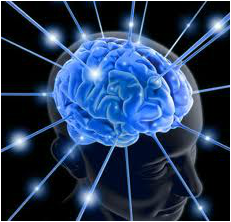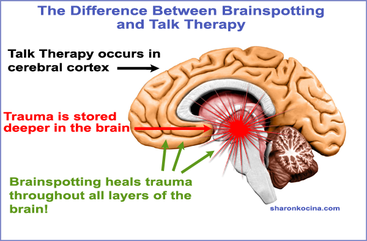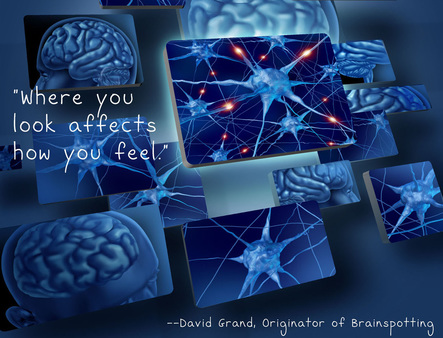What Is Brainspotting?

Brainspotting is a gentle, powerful, focused mindfulness, emotional healing tool based on current neuroscientific understanding of how our mind/body system stores and processes memories, emotions, and trauma; and that the brain knows how to heal itself.
Emotion, and pain, which when untreated, create "capsules" within us that can interfere with goal achievement, relationship satisfaction, daily functioning, and peace of mind.
Brainspotting is designed to reach the unconscious mind/body storage to help process and release the emotional charge around past experiences and faulty self-perceptions much more quickly and effectively than many traditional therapies, including talk therapy.
Emotion, and pain, which when untreated, create "capsules" within us that can interfere with goal achievement, relationship satisfaction, daily functioning, and peace of mind.
Brainspotting is designed to reach the unconscious mind/body storage to help process and release the emotional charge around past experiences and faulty self-perceptions much more quickly and effectively than many traditional therapies, including talk therapy.
What does a Brainspotting session look like?

When you come in for a Brainspotting session, with the support of the therapist, you will choose the topic you want to begin healing. Topics can include performance issues, grief, physical pain, specific memories or experiences, behavior addictions (food, gambling, sex, etc), or relationship issues. Most issues can be helped through Brainspotting.
Brainspotting uses bilateral sounds--recordings that slowly pan back and forth through headphones from one ear to the other--to support the emotional healing process. This is provided during our Brainspotting session.
Once you have identified your topic, you'll be guided to check in with your body sense to locate where the emotion is showing up. Emotions make themselves known as headaches, muscle soreness, stomach issues, and many other body sensations. Everyone is different, and every issue has it's own mind-body storage location, so we check in at each Brainspotting session, and often several times throughout one session.
Using a pointer, your therapist will help you locate your Brainspot for the topic you chose. The Brainspot is found along your field of vision, and correlates with the intensity of the body sensations, and gives you access to the subconscious capsule where the emotional issue content is stored in the mind/body system. Your therapist will hold the pointer in place throughout the next step: watching the internal healing happen.
Your only job is to pay attention from the inside and see what comes up around the topic you chose as you and your therapist "hold the space" for the processing to take place. How this processing manifests is different for each individual. Some people have very visual and pictorial processing sessions, with many images flashing through. Others experience the body sensations shift and change throughout the session; others are more verbal, with narrative coming to their awareness. These are just a few of the ways our brain/mind/body systems bring to light stuck places to be released.
At the end of the processing time, you and your therapist will gently explore your experience of the Brainspotting session. What new insights came up for you, what feels different now versus before the Brainspotting session, what action steps became clear for you, how the original topic might have shifted, might be a few of the questions explored in the debriefing time.
Since Brainspotting works at a subcortical level (i.e., subconscious), it might be a few days, weeks, or even months to become aware of the healing that takes place in one Brainspotting session. Additionally, once a subconsious "capsule" is tapped into during a Brainspotting session, your mind/body system will continue to process and work on the emotional healing long afterwards.
Most people feel relief after one Brainspotting session. Longer term issues may need more processing over time. Brainspotting work is client-directed and can last anywhere from one to twelve sessions for a single topic.
Brainspotting uses bilateral sounds--recordings that slowly pan back and forth through headphones from one ear to the other--to support the emotional healing process. This is provided during our Brainspotting session.
Once you have identified your topic, you'll be guided to check in with your body sense to locate where the emotion is showing up. Emotions make themselves known as headaches, muscle soreness, stomach issues, and many other body sensations. Everyone is different, and every issue has it's own mind-body storage location, so we check in at each Brainspotting session, and often several times throughout one session.
Using a pointer, your therapist will help you locate your Brainspot for the topic you chose. The Brainspot is found along your field of vision, and correlates with the intensity of the body sensations, and gives you access to the subconscious capsule where the emotional issue content is stored in the mind/body system. Your therapist will hold the pointer in place throughout the next step: watching the internal healing happen.
Your only job is to pay attention from the inside and see what comes up around the topic you chose as you and your therapist "hold the space" for the processing to take place. How this processing manifests is different for each individual. Some people have very visual and pictorial processing sessions, with many images flashing through. Others experience the body sensations shift and change throughout the session; others are more verbal, with narrative coming to their awareness. These are just a few of the ways our brain/mind/body systems bring to light stuck places to be released.
At the end of the processing time, you and your therapist will gently explore your experience of the Brainspotting session. What new insights came up for you, what feels different now versus before the Brainspotting session, what action steps became clear for you, how the original topic might have shifted, might be a few of the questions explored in the debriefing time.
Since Brainspotting works at a subcortical level (i.e., subconscious), it might be a few days, weeks, or even months to become aware of the healing that takes place in one Brainspotting session. Additionally, once a subconsious "capsule" is tapped into during a Brainspotting session, your mind/body system will continue to process and work on the emotional healing long afterwards.
Most people feel relief after one Brainspotting session. Longer term issues may need more processing over time. Brainspotting work is client-directed and can last anywhere from one to twelve sessions for a single topic.
How Brainspotting Can Help

Brainspotting can help decrease depression, anxiety, phobias, and addictions. It is used with all areas of trauma, including survivors of war, natural disasters, and emotional and physical abuse. Brainspotting is also used for certain medical conditions, including traumatic brain injuries, strokes, fibromyalgia, headaches, and preparation and recovery from surgery.
In addition, Brainspotting can be used for performance enhancement such as sports, acting, public speaking, auditions, and other types of performance-related experiences. Brainspotting works well with children, adolescents, and adults.
It is important to understand that Brainspotting is done in such a way that the client is not retraumatized by reliving the original experience. The mindful attention between you and your therapist allows for a safe space as Brainspotting helps the brain/mind/body to work in harmony to dismantle the trauma, symptom, body distress, and outdated beliefs so that new, more adaptive perspectives and inner resources can develop.
In addition, Brainspotting can be used for performance enhancement such as sports, acting, public speaking, auditions, and other types of performance-related experiences. Brainspotting works well with children, adolescents, and adults.
It is important to understand that Brainspotting is done in such a way that the client is not retraumatized by reliving the original experience. The mindful attention between you and your therapist allows for a safe space as Brainspotting helps the brain/mind/body to work in harmony to dismantle the trauma, symptom, body distress, and outdated beliefs so that new, more adaptive perspectives and inner resources can develop.
How Emotional Issues Can Affect Us
|
It is not so much the traumatic or hurtful event that determines the emotional pain; it is the way we respond and cope with the event that will determine whether or not symptoms will develop.
Common types of emotional issues include: Sexual or physical abuse Experiencing or witnessing an accident Natural disasters Military combat Sudden serious medical diagnosis Medical treatment process Unexpected life change Bullying Exposure to constant aggression or threat Early attachment difficulties Traumatic pregnancy and/or delivery Loss of a loved one Symptoms of emotional issues can include: Intense feelings of anger/despair Sleeplessness Anxiety or phobias Flashbacks Hyperarousal to external or internal stimulus Numbness or detachment emotionally or physically Mood swings Waiting for the next catastrophe Nightmares and night terrors |
Learn more about Brainspotting
Brainspotting International website
https://brainspotting.com/
Midwest Brainspotting Institute
https://midwestbrainspottinginstitute.org/
Brainspotting
by Dr. David Grand
Available on Amazon.com
Lynn loves using Brainspotting with clients because it is in alignment with both up-to-date brain science and Lynn's spiritual psychology perspective. Give it a try!
https://brainspotting.com/
Midwest Brainspotting Institute
https://midwestbrainspottinginstitute.org/
Brainspotting
by Dr. David Grand
Available on Amazon.com
Lynn loves using Brainspotting with clients because it is in alignment with both up-to-date brain science and Lynn's spiritual psychology perspective. Give it a try!
